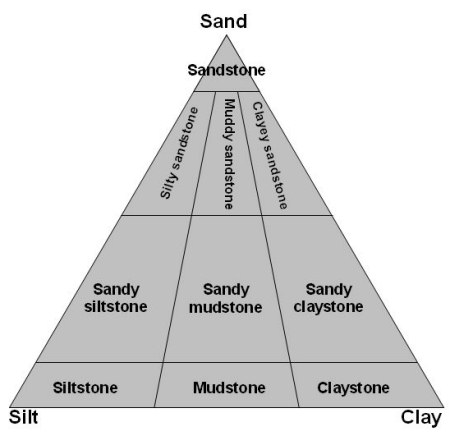
Delabole Slate
Quarry
Geology
Geologists are usually very strict when it comes to rules on
sedimentary rocks. Sediments are distinguished by particle size
into gravel, sand, silt and clay. When a
claystone has what is known as fissility
or ability to be split in more or less thin layers it becomes
shale. Silica cement can make shale
harder but usually the rock is fairly soft and weathers easily back
to clay. When shale is subject to heat and pressure it eventually
turns into the lowest grade of metamorphic or shape-changed rock,
slate. The clays have then started to
revert to the mica minerals from which they were formed. When
transformed from shale, slate grows harder and the cleavage
direction gets more pronounced. An easy way to tell slate from
shale is to tap it with a hammer. If it rings or
“tinks” it is slate. If the temperature and pressure is
even higher the slate first turns into
phyllite, then
schist and finally into
gneiss.

Slate comes in different colours and can be grey, black, blue,
red, green and even purple. Dark slates usually owe their colour to
iron sulfide or carbonaceous material. Red and purple slate usually
carries iron oxide (hematite) and green slate owe its hue to
clorite, a green clay material. The main minerals in slate are
muscovite and biotote, quartz and chlorite. Slate has a dull lustre
and a strong cleavage.
Usage
Throughout the years slate has had many uses. Examples are
building stones, roof tiles, flooring, road paving, pool tables,
writing tablets and blackboards. When quarried, slates are split
from blocks about 3 inches thick. A chisel in position at the edge
of the block is lightly tapped with a mallet. A thin crack opens in
the direction of the cleavage and a gentle leverage with the chisel
splits the block into two smooth and even pieces. This procedure is
repeated over and over again until the original block is split into
up to 18 pieces. These are thereafter trimmed to size by hand or by
machines. Slate is also crushed to make composition roofing and to
be used as a filler.
Delabole
slate
Delabole slate quarry is said to be the deepest manmade hole in
Britain, 425 feet deep and over a mile and a half in circumference.
The workings are supposed to have started as early as the
13th century and is definitely known to have been
in use since Elizabethan times. In 1841 five separate pits were
amalgamated into one single quarry. In those days, hundreds of men
were needed for tasks such as blasting, drilling, digging and
splitting the slabs. Today only five men are needed to perform
these tasks. Modern quarrying techniques and diamond wire saws have
transformed the backbreaking ordeals of previous centuries. Up to
120 tonnes of slate blocks is extracted every day.
The coordinates lead to the view point, a ledge teetering on the
brink of the gaping mouth of the quarry.
To log your visit you have to email me the answers to these
questions:
1. In the car park there is a slate sign saying “COACH
PARK and ………..”. Fill in the three words
missing.
2. The working face of the quarry, that is the terraced side
without rubbish heaps, is facing approximately which compass
direction?
3. At the showroom entrance there is a semicircle of wooden
pillars. How many are there in the INNER semicircle counting the
central pillar as well?
4. A photo of yourself at the pit would be much appreciated but
is not necessary to complete the cache.
Send your answers to the cache owner and wait for an OK before
you log your visit, please.
Good luck!
 The most exciting way to
learn about the Earth and its processes is to get into the outdoors
and experience it first-hand. Visiting an Earthcache is a great
outdoor activity the whole family can enjoy. An Earthcache is a
special place that people can visit to learn about a unique
geoscience feature or aspect of our Earth. Earthcaches include a
set of educational notes and the details about where to find the
location (latitude and longitude). Visitors to Earthcaches can see
how our planet has been shaped by geological processes, how we
manage the resources and how scientists gather evidence to learn
about the Earth. To find out more click HERE.
The most exciting way to
learn about the Earth and its processes is to get into the outdoors
and experience it first-hand. Visiting an Earthcache is a great
outdoor activity the whole family can enjoy. An Earthcache is a
special place that people can visit to learn about a unique
geoscience feature or aspect of our Earth. Earthcaches include a
set of educational notes and the details about where to find the
location (latitude and longitude). Visitors to Earthcaches can see
how our planet has been shaped by geological processes, how we
manage the resources and how scientists gather evidence to learn
about the Earth. To find out more click HERE.
